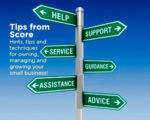Trade Shows
 Question: I use trade shows to reach my audience. What are the most common mistakes that small businesses make when exhibiting?
Question: I use trade shows to reach my audience. What are the most common mistakes that small businesses make when exhibiting?
Answer: Whether you are small or large, the mistakes are very similar. Whether you have a table top at Philanthropy Day or an exhibit at the Rotary Club’s Home and Garden Show or a table top at Enterprising Women, the best practices are the same.
Not planning ahead – Time is a major competitor for the small business owner. How do we get it all done with so little time? If you are not starting your trade show plan six months in advance of the show with 3, 2 and one month milestones you are in trouble from the start. Part of the planning process is to set specific, focused, quantifiable and measurable objectives.
Researching your target market – Make sure that you understand who you are trying to reach and that they will be attending. If you offer residential cleaning services, will visitors to the Rotary Home and Garden Show be looking for your service? If you sell ductless air conditioning systems, will visitors to the Expo be in your target audience? Understand who attends and what they are looking for while visiting the show before buying space.
Going Cheap, Looking Cheap – You need to look like you are in business. Like you are a professional organization. If you focus on the cost of exhibiting, not how the message you are communicating by your presence, you will not appear to be best in class among competitors.
Missing deadlines – One way to drive up your exhibiting costs is to miss the shows deadlines for submittal of forms and show service orders. Read the exhibitor’s manual and keep the schedule for submittals top of mind. And by the way, understand the show rules. Saves lots of headaches on set up day.
Not starting the conversation before the show open – for buyers to know you are exhibiting, you need to tell them by pre-show promotion. Whether it emails, a postcard campaign, personal invitation, or advertisements in the Cape Cod Times, you need to give good reasons for buyers to come to the show and specifically visit your exhibit.
Bad graphics – Your graphics are the magnets that attract visitors to your exhibit. They communicate who you are, what you do and what it is your offer. And, your graphics need to be large and legible from 10-15 feet away. They need to be professionally designed and produced.
No follow-up system in place – Nationally 86% of exhibitors go to trade shows to generate leads for sales, but 79% of those leads are never followed up. You need a follow-up plan before going to the show so that as soon as it is over, you are following all categories of leads.
Not taking detailed notes – Once you disengage with a visitor to your exhibit take notes if you expect to remember what action you agreed upon or you’ll lose out on the opportunity to make a sale. Take notes on your lead form, so you can have the details to make a meaningful follow-up.
No measurement in place – Without measurement, there is no way to know what worked and what didn’t work in the way of strategies and tactics employed while exhibiting. Did your preshow promotion attract visitors to your exhibit? If so, how many? How many of those were converted into the qualifiable leads?
Forgetting about Social Media – Do your customers use Facebook, LinkedIn, YouTube, or Twitter. Find out where your customers get their information and be there, before, during and after the show. Take pictures in your exhibit and post them during the event to drive traffic to your exhibit to find out what you are offering. Use technology to your advantage.
Not preparing your staff – Just because your staff can sell every day in the field to your customer base, doesn’t mean they can be successful at your exhibit at a trade show. They need to have their skills transitioned to the unique selling environment of the trade show through training and preparation.
Not having a Plan B – What happens if one of your staffers gets the flu or has a sick child and cannot work the show? What happens if your exhibit violates show rules? You need to have a backup plan for all of these situations.
Not listening – Exhibiting is all about listening to customer needs and filling those needs. It is about not doing all the talking and doing an information dump, but listening and understanding the buyer’s perspective.











